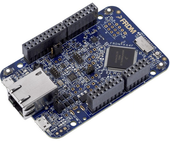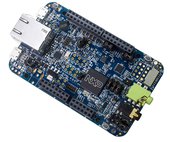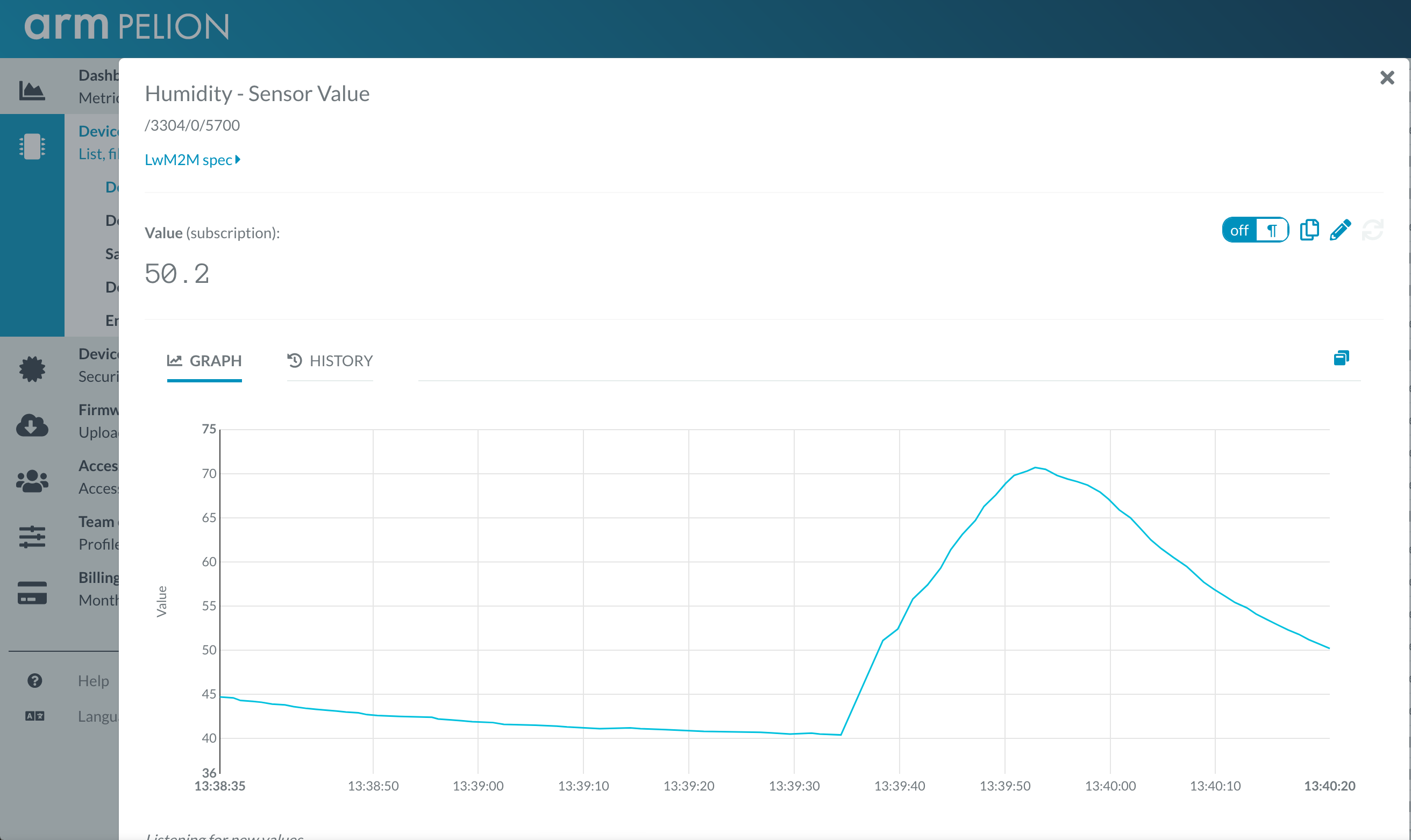Mbed OS and Pelion Device Management example for FRDM-K64F and FRDM-K66F boards
Dependencies: FXAS21002 FXOS8700Q
This example is known to work great on the following platforms:
- FRDM-K64F - onboard Ethernet and onboard SD card holder.
- FRDM-K66F - onboard Ethernet and onboard SD card holder.
Follow the Quick-Start instructions: https://cloud.mbed.com/quick-start


Example functionality
This example showcases the following device functionality:
- Read onboard FXOS8700Q accelerometer and magnetometer, and report the values as Pelion LWM2M resources (see image below).
- (FRDM-K66F only) Read onboard FXAS21002 gyroscope and report the values as Pelion LWM2M resources.
- On user button click, increment Pelion LWM2M button resource.
- Allow the user to change the state of the board LED from Pelion LWM2M led_state resource and PUT request.

Use this example with Mbed CLI
1. Import the application into your desktop:
mbed import https://os.mbed.com/teams/NXP/code/pelion-example-frdm cd pelion-example-frdm
2. Install the CLOUD_SDK_API_KEY
mbed config -G CLOUD_SDK_API_KEY <PELION_DM_API_KEY>
For instructions on how to generate your API key, please see the documentation.
3. Initialize firmware credentials (done once per repository). You can use the following command:
mbed dm init -d "<your company name in Pelion DM>" --model-name "<product model identifier>" -q --force
If above command do not work for your Mbed CLI, please consider upgrading Mbed CLI to version 1.9.x or above.
4. Compile and program:
mbed compile -t <toolchain> -m <TARGET_BOARD>
(supported toolchains : GCC_ARM / ARM / IAR)
5. You can connect on a virtual terminal/COM port to the platform using:
mbed sterm -b 115200
This should give you an output similar to:
[BOOT] Mbed Bootloader [BOOT] ARM: 00000000000000000000 [BOOT] OEM: 00000000000000000000 [BOOT] Layout: 0 8374 [BOOT] Active firmware integrity check: [BOOT] SHA256: 411F422DE8FF545E2D3C373E87D5328162A129314A655AEC32B9A167DE29177E [BOOT] Version: 1553606618 [BOOT] Slot 0 is empty [BOOT] Active firmware up-to-date [BOOT] Application's start address: 0x10400 [BOOT] Application's jump address: 0x112C1 [BOOT] Application's stack address: 0x20030000 [BOOT] Forwarding to application... Starting Simple Pelion Device Management Client example You can hold the user button during boot to format the storage and change the device identity. Sensors configuration: FXOS8700Q accelerometer = 0xC7 FXOS8700Q magnetometer = 0xC7 FXAS21002 gyroscope = 0xB7 Connecting to the network using the default network interface... Connected to the network successfully. IP address: 10.2.202.65 Initializing Pelion Device Management Client... Initialized Pelion Device Management Client. Registering... Press the user button to increment the LwM2M resource value... FXOS8700Q mag: 0.312 x, 0.039 y, -1.625 z [gauss] FXOS8700Q acc: 0.139 x, -0.123 y, 4.260 z [g] FXAS21002 gryo: 13.089 x, 13.089 y, 13.089 z [dps]
Diff: main.cpp
- Revision:
- 0:a9d53048f0b6
- Child:
- 1:42d51cf7cebe
--- /dev/null Thu Jan 01 00:00:00 1970 +0000
+++ b/main.cpp Mon Mar 25 14:58:08 2019 +0000
@@ -0,0 +1,183 @@
+// ----------------------------------------------------------------------------
+// Copyright 2016-2018 ARM Ltd.
+//
+// SPDX-License-Identifier: Apache-2.0
+//
+// Licensed under the Apache License, Version 2.0 (the "License");
+// you may not use this file except in compliance with the License.
+// You may obtain a copy of the License at
+//
+// http://www.apache.org/licenses/LICENSE-2.0
+//
+// Unless required by applicable law or agreed to in writing, software
+// distributed under the License is distributed on an "AS IS" BASIS,
+// WITHOUT WARRANTIES OR CONDITIONS OF ANY KIND, either express or implied.
+// See the License for the specific language governing permissions and
+// limitations under the License.
+// ----------------------------------------------------------------------------
+#ifndef MBED_TEST_MODE
+
+#include "mbed.h"
+#include "simple-mbed-cloud-client.h"
+#include "FATFileSystem.h"
+#include "LittleFileSystem.h"
+
+// Default network interface object. Don't forget to change the WiFi SSID/password in mbed_app.json if you're using WiFi.
+NetworkInterface *net = NetworkInterface::get_default_instance();
+
+// Default block device available on the target board
+BlockDevice *bd = BlockDevice::get_default_instance();
+
+#if COMPONENT_SD || COMPONENT_NUSD
+// Use FATFileSystem for SD card type blockdevices
+FATFileSystem fs("fs", bd);
+#else
+// Use LittleFileSystem for non-SD block devices to enable wear leveling and other functions
+LittleFileSystem fs("fs", bd);
+#endif
+
+#if USE_BUTTON == 1
+InterruptIn button(BUTTON1);
+#endif /* USE_BUTTON */
+
+// Default LED to use for PUT/POST example
+DigitalOut led(LED1);
+
+// Declaring pointers for access to Pelion Device Management Client resources outside of main()
+MbedCloudClientResource *button_res;
+MbedCloudClientResource *led_res;
+MbedCloudClientResource *post_res;
+
+// An event queue is a very useful structure to debounce information between contexts (e.g. ISR and normal threads)
+// This is great because things such as network operations are illegal in ISR, so updating a resource in a button's fall() function is not allowed
+EventQueue eventQueue;
+
+/**
+ * PUT handler - sets the value of the built-in LED
+ * @param resource The resource that triggered the callback
+ * @param newValue Updated value for the resource
+ */
+void put_callback(MbedCloudClientResource *resource, m2m::String newValue) {
+ printf("PUT received. New value: %s\n", newValue.c_str());
+ led = atoi(newValue.c_str());
+}
+
+/**
+ * POST handler - prints the content of the payload
+ * @param resource The resource that triggered the callback
+ * @param buffer If a body was passed to the POST function, this contains the data.
+ * Note that the buffer is deallocated after leaving this function, so copy it if you need it longer.
+ * @param size Size of the body
+ */
+void post_callback(MbedCloudClientResource *resource, const uint8_t *buffer, uint16_t size) {
+ printf("POST received (length %u). Payload: ", size);
+ for (size_t ix = 0; ix < size; ix++) {
+ printf("%02x ", buffer[ix]);
+ }
+ printf("\n");
+}
+
+/**
+ * Button handler
+ * This function will be triggered either by a physical button press or by a ticker every 5 seconds (see below)
+ */
+void button_press() {
+ int v = button_res->get_value_int() + 1;
+ button_res->set_value(v);
+ printf("Button clicked %d times\n", v);
+}
+
+/**
+ * Notification callback handler
+ * @param resource The resource that triggered the callback
+ * @param status The delivery status of the notification
+ */
+void button_callback(MbedCloudClientResource *resource, const NoticationDeliveryStatus status) {
+ printf("Button notification, status %s (%d)\n", MbedCloudClientResource::delivery_status_to_string(status), status);
+}
+
+/**
+ * Registration callback handler
+ * @param endpoint Information about the registered endpoint such as the name (so you can find it back in portal)
+ */
+void registered(const ConnectorClientEndpointInfo *endpoint) {
+ printf("Registered to Pelion Device Management. Endpoint Name: %s\n", endpoint->internal_endpoint_name.c_str());
+}
+
+int main(void) {
+ printf("\nStarting Simple Pelion Device Management Client example\n");
+
+#if USE_BUTTON == 1
+ // If the User button is pressed ons start, then format storage.
+ if (button.read() == MBED_CONF_APP_BUTTON_PRESSED_STATE) {
+ printf("User button is pushed on start. Formatting the storage...\n");
+ int storage_status = StorageHelper::format(&fs, bd);
+ if (storage_status != 0) {
+ printf("ERROR: Failed to reformat the storage (%d).\n", storage_status);
+ }
+ } else {
+ printf("You can hold the user button during boot to format the storage and change the device identity.\n");
+ }
+#endif /* USE_BUTTON */
+
+ // Connect to the Internet (DHCP is expected to be on)
+ printf("Connecting to the network using the default network interface...\n");
+ net = NetworkInterface::get_default_instance();
+
+ nsapi_error_t net_status = NSAPI_ERROR_NO_CONNECTION;
+ while ((net_status = net->connect()) != NSAPI_ERROR_OK) {
+ printf("Unable to connect to network (%d). Retrying...\n", net_status);
+ }
+
+ printf("Connected to the network successfully. IP address: %s\n", net->get_ip_address());
+
+ printf("Initializing Pelion Device Management Client...\n");
+
+ // SimpleMbedCloudClient handles registering over LwM2M to Pelion Device Management
+ SimpleMbedCloudClient client(net, bd, &fs);
+ int client_status = client.init();
+ if (client_status != 0) {
+ printf("Pelion Client initialization failed (%d)\n", client_status);
+ return -1;
+ }
+
+ // Creating resources, which can be written or read from the cloud
+ button_res = client.create_resource("3200/0/5501", "button_count");
+ button_res->set_value(0);
+ button_res->methods(M2MMethod::GET);
+ button_res->observable(true);
+ button_res->attach_notification_callback(button_callback);
+
+ led_res = client.create_resource("3201/0/5853", "led_state");
+ led_res->set_value(led.read());
+ led_res->methods(M2MMethod::GET | M2MMethod::PUT);
+ led_res->attach_put_callback(put_callback);
+
+ post_res = client.create_resource("3300/0/5605", "execute_function");
+ post_res->methods(M2MMethod::POST);
+ post_res->attach_post_callback(post_callback);
+
+ printf("Initialized Pelion Device Management Client. Registering...\n");
+
+ // Callback that fires when registering is complete
+ client.on_registered(®istered);
+
+ // Register with Pelion DM
+ client.register_and_connect();
+
+#if USE_BUTTON == 1
+ // The button fires on an interrupt context, but debounces it to the eventqueue, so it's safe to do network operations
+ button.fall(eventQueue.event(&button_press));
+ printf("Press the user button to increment the LwM2M resource value...\n");
+#else
+ // The timer fires on an interrupt context, but debounces it to the eventqueue, so it's safe to do network operations
+ Ticker timer;
+ timer.attach(eventQueue.event(&button_press), 5.0);
+ printf("Simulating button press every 5 seconds...\n");
+#endif /* USE_BUTTON */
+
+ // You can easily run the eventQueue in a separate thread if required
+ eventQueue.dispatch_forever();
+}
+
+#endif /* MBED_TEST_MODE */

